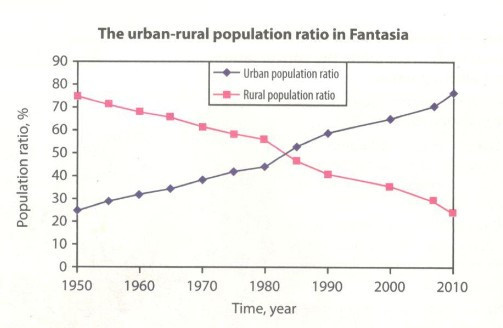SBT Tiếng Anh 12 mới Unit 2: Writing trang 17
Hướng dẫn giải sách bài tập Tiếng Anh lớp 12 Unit 2: Writing trang 17 giúp học sinh làm bài tập trong SBT Tiếng Anh 12 dễ dàng.
Giải SBT Tiếng Anh 12 Unit 2: Writing trang 17
1. (Trang 17 - Tiếng Anh 12): Look at the line graph and answer the following questions.
(Xem biểu đồ đường và trả lời các câu hỏi dưới đây)

Đáp án:
1. What does the graph show?
=> It shows the urban-rural population ratio in Fantasia from 1950 to 2010.
(Biểu đồ cho thấy gì?
=> Nó cho thấy tỷ lệ dân số đô thị và nông thôn ở Fantasia 1950-2010.)
2. What information is shown on the vertical axis?
=> The population ratio in percentage.
(Thông tin gì được thể hiện trên trục tung?
=> Tỷ lệ dân số theo phần trăm.)
3. What information is shown on the horizontal axis?
=> The 60-year period from 1950 to 2010 (divided by ten-year intervals).
(Thông tin gì được thể hiện trên trục hoành?
=> Giai đoạn 60 năm 1950-2010 (chia khoảng thời gian mười năm).)
4. What patterns can you see?
=> The urban population ratio increased, and the rural population ratio decreased.
(Bạn có thể thấy đường hướng diễn ra nào?
=> Tỷ lệ dân số đô thị tăng lên, và tỷ lệ dân số nông thôn giảm.)
5. What comparisons can you make?
=> The differences between the two patterns.
(Những so sánh nào bạn có thể thực hiện?
=> Sự khác biệt giữa hai mô hình.)
2. (Trang 17 - Tiếng Anh 12): Rewrite the sentences without changing their meaning.
(Viết lại câu mà không làm thay đổi nghĩa)
1. The urban population ratio rose steadily throughout the period.
=> There was a steady rise in the urban population ratio throughout the period.
(Có sự gia tăng ổn định trong tỷ lệ dân số đô thị trong suốt thời kỳ.)
2. There was a continuous fall in the rural population ratio during this 60-year period.
=> The rural population ratio fell continuously during this 60-year period.
(Tỷ lệ dân số nông thôn giảm dần trong giai đoạn 60 năm này.)
3. The urban population ratio rose from 25% to 45% between 1950 and 1980.
=> There was a rise/increase of 20% in the urban population ratio between 1950 and 1980.
(Có sự tăng 20% trong tỷ lệ dân số đô thị từ năm 1950 đến 1980.)
4. From 1980 to 2010, there was a steady increase in the ratio of urban population.
=> From 1980 to 2010, the ratio of urban population increased steadily.
(Từ 1980 đến 2010, tỷ lệ dân thành thị tăng đều đặn.)
5. The rural population ratio decreased by 50% from 1950 to 2010.
=> There was a decrease/fall of 50% in the rural population ratio from 1950 to 2010.
(Tỷ lệ dân số nông thôn đã giảm 50% từ năm 1950 đến 2010.)
3. (Trang 17 - Tiếng Anh 12): Write a description (of 130-150 words) of the trends in the graph.
(Viết đoạn mô tả (130-150 từ) về các xu hướng trên biểu đồ.)
Gợi ý:
The line graph illustrates the ratio between urban and rural population in Fantasia over a 60-year period from 1950 to 2010. Overall, the ratio of urban population went up continuously, while the rural population ratio experienced a steady fall.
In 1950,75% of the population lived in rural areas compared to only 25% of urban dwellers at the time. The next 30-year period saw some changes in the trend with more people (around 45%) living in urban areas and fewer people (less than 60%) living in rural areas.
Towards the end of the period, the trend was totally reversed. In 2010, around 75% of the population lived in urban areas, whereas just merely 25% still lived in rural areas.
In summary, as time went by, more and more people chose the city over rural areas to settle down.
Hướng dẫn dịch:
Biểu đồ minh họa tỷ lệ giữa số dân đô thị và nông thôn ở Fantasia trong khoảng thời gian 60 năm từ năm 1950 đến năm 2010. Nhìn chung, tỷ lệ dân số đô thị đã tăng liên tục, trong khi tỷ lệ dân cư nông thôn đã giảm ở mức ổn định.
Năm 1950,75% dân số sống ở khu vực nông thôn so với chỉ 25% của cư dân đô thị vào thời điểm đó. khoảng thời gian 30 năm sau đã thấy một số thay đổi trong xu hướng với nhiều người hơn (khoảng 45%) sống ở khu vực đô thị và ít người hơn (dưới 60%) sống ở khu vực nông thôn.
Đến cuối giai đoạn này, xu hướng đã hoàn toàn đảo ngược. Trong năm 2010, khoảng 75% dân số sống ở khu vực đô thị, trong khi đó chỉ đơn thuần 25% vẫn còn sinh sống ở các khu vực nông thôn.
Tóm lại, khi thời gian trôi qua, ngày càng có nhiều người chọn thành phố hơn là khu vực nông thôn để định cư.
Xem thêm các bài giải sách bài tập Tiếng Anh lớp 12 mới chi tiết, hay khác:
Pronunciation (trang 12): Choose the word with the underlined part pronounced differently from the rest...
Vocabulary & Grammar (trang 13): Do the following crossword puzzle. (Giải câu đố ô chữ dưới đây)...
Reading (trang 16): Read the text about urbanisation and choose the best title...
Speaking (trang 16): Put the following features of city life into the appropriate column. (Đặt những đặc điểm của cuộc sống đô thị vào cột phù hợp)...
Xem thêm các chương trình khác:
